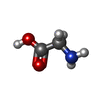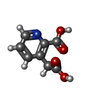[English] 日本語
 Yorodumi
Yorodumi- PDB-6uzg: Crystal structure of GLUN1/GLUN2A-4M mutant ligand-binding domain... -
+ Open data
Open data
- Basic information
Basic information
| Entry | Database: PDB / ID: 6uzg | |||||||||
|---|---|---|---|---|---|---|---|---|---|---|
| Title | Crystal structure of GLUN1/GLUN2A-4M mutant ligand-binding domain in complex with glycine and homoquinolinic acid | |||||||||
 Components Components |
| |||||||||
 Keywords Keywords | MEMBRANE PROTEIN / NMDAR / ligand-binding domain / agonist | |||||||||
| Function / homology |  Function and homology information Function and homology informationneurotransmitter receptor transport, plasma membrane to endosome / regulation of response to alcohol / response to ammonium ion / receptor recycling / response to hydrogen sulfide / positive regulation of inhibitory postsynaptic potential / directional locomotion / response to environmental enrichment / response to other organism / regulation of ARF protein signal transduction ...neurotransmitter receptor transport, plasma membrane to endosome / regulation of response to alcohol / response to ammonium ion / receptor recycling / response to hydrogen sulfide / positive regulation of inhibitory postsynaptic potential / directional locomotion / response to environmental enrichment / response to other organism / regulation of ARF protein signal transduction / pons maturation / response to methylmercury / positive regulation of Schwann cell migration / regulation of cell communication / EPHB-mediated forward signaling / Assembly and cell surface presentation of NMDA receptors / serotonin metabolic process / olfactory learning / response to carbohydrate / dendritic branch / cellular response to dsRNA / conditioned taste aversion / cellular response to lipid / regulation of respiratory gaseous exchange / cellular response to magnesium ion / protein localization to postsynaptic membrane / conditioned place preference / propylene metabolic process / response to glycine / sleep / locomotion / dendritic spine organization / response to manganese ion / regulation of monoatomic cation transmembrane transport / voltage-gated monoatomic cation channel activity / Synaptic adhesion-like molecules / NMDA glutamate receptor activity / regulation of NMDA receptor activity / RAF/MAP kinase cascade / parallel fiber to Purkinje cell synapse / NMDA selective glutamate receptor complex / response to morphine / cellular response to zinc ion / calcium ion transmembrane import into cytosol / glutamate binding / glutamate receptor signaling pathway / neuromuscular process / protein heterotetramerization / regulation of synapse assembly / positive regulation of calcium ion transport into cytosol / positive regulation of reactive oxygen species biosynthetic process / glycine binding / regulation of axonogenesis / male mating behavior / regulation of dendrite morphogenesis / spinal cord development / action potential / suckling behavior / startle response / response to amine / dopamine metabolic process / monoatomic cation transmembrane transport / regulation of neuronal synaptic plasticity / response to lithium ion / modulation of excitatory postsynaptic potential / associative learning / monoatomic cation transport / social behavior / excitatory synapse / ligand-gated monoatomic ion channel activity / regulation of postsynaptic membrane potential / positive regulation of excitatory postsynaptic potential / cellular response to glycine / positive regulation of dendritic spine maintenance / postsynaptic density, intracellular component / response to light stimulus / positive regulation of protein targeting to membrane / neuron development / multicellular organismal response to stress / Unblocking of NMDA receptors, glutamate binding and activation / cellular response to manganese ion / phosphatase binding / glutamate receptor binding / long-term memory / regulation of neuron apoptotic process / prepulse inhibition / monoatomic cation channel activity / calcium ion homeostasis / glutamate-gated receptor activity / synaptic cleft / cell adhesion molecule binding / response to fungicide / glutamate-gated calcium ion channel activity / presynaptic active zone membrane / dendrite membrane / ligand-gated monoatomic ion channel activity involved in regulation of presynaptic membrane potential / sensory perception of pain / response to amphetamine / ionotropic glutamate receptor signaling pathway / protein tyrosine kinase binding Similarity search - Function | |||||||||
| Biological species |  | |||||||||
| Method |  X-RAY DIFFRACTION / X-RAY DIFFRACTION /  SYNCHROTRON / SYNCHROTRON /  MOLECULAR REPLACEMENT / Resolution: 1.94 Å MOLECULAR REPLACEMENT / Resolution: 1.94 Å | |||||||||
 Authors Authors | Wang, J.X. / Furukawa, H. | |||||||||
| Funding support |  United States, 2items United States, 2items
| |||||||||
 Citation Citation |  Journal: Nat Commun / Year: 2020 Journal: Nat Commun / Year: 2020Title: Structural basis of subtype-selective competitive antagonism for GluN2C/2D-containing NMDA receptors. Authors: Wang, J.X. / Irvine, M.W. / Burnell, E.S. / Sapkota, K. / Thatcher, R.J. / Li, M. / Simorowski, N. / Volianskis, A. / Collingridge, G.L. / Monaghan, D.T. / Jane, D.E. / Furukawa, H. | |||||||||
| History |
|
- Structure visualization
Structure visualization
| Structure viewer | Molecule:  Molmil Molmil Jmol/JSmol Jmol/JSmol |
|---|
- Downloads & links
Downloads & links
- Download
Download
| PDBx/mmCIF format |  6uzg.cif.gz 6uzg.cif.gz | 303 KB | Display |  PDBx/mmCIF format PDBx/mmCIF format |
|---|---|---|---|---|
| PDB format |  pdb6uzg.ent.gz pdb6uzg.ent.gz | 204.2 KB | Display |  PDB format PDB format |
| PDBx/mmJSON format |  6uzg.json.gz 6uzg.json.gz | Tree view |  PDBx/mmJSON format PDBx/mmJSON format | |
| Others |  Other downloads Other downloads |
-Validation report
| Summary document |  6uzg_validation.pdf.gz 6uzg_validation.pdf.gz | 340.1 KB | Display |  wwPDB validaton report wwPDB validaton report |
|---|---|---|---|---|
| Full document |  6uzg_full_validation.pdf.gz 6uzg_full_validation.pdf.gz | 340.1 KB | Display | |
| Data in XML |  6uzg_validation.xml.gz 6uzg_validation.xml.gz | 1.4 KB | Display | |
| Data in CIF |  6uzg_validation.cif.gz 6uzg_validation.cif.gz | 8.9 KB | Display | |
| Arichive directory |  https://data.pdbj.org/pub/pdb/validation_reports/uz/6uzg https://data.pdbj.org/pub/pdb/validation_reports/uz/6uzg ftp://data.pdbj.org/pub/pdb/validation_reports/uz/6uzg ftp://data.pdbj.org/pub/pdb/validation_reports/uz/6uzg | HTTPS FTP |
-Related structure data
| Related structure data |  6uz6C  6uzrC  6uzwC  6uzxC  4nf8S S: Starting model for refinement C: citing same article ( |
|---|---|
| Similar structure data |
- Links
Links
- Assembly
Assembly
| Deposited unit | 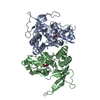
| ||||||||||||
|---|---|---|---|---|---|---|---|---|---|---|---|---|---|
| 1 |
| ||||||||||||
| Unit cell |
|
- Components
Components
| #1: Protein | Mass: 33340.031 Da / Num. of mol.: 1 Fragment: ligand-binding domain (UNP residues 415-565,684-821) Source method: isolated from a genetically manipulated source Source: (gene. exp.)   |
|---|---|
| #2: Protein | Mass: 31858.482 Da / Num. of mol.: 1 Fragment: ligand-binding domain (UNP residues 402-539,661-802) Mutation: A414R, K738M, G740R, R741K Source method: isolated from a genetically manipulated source Source: (gene. exp.)   |
| #3: Chemical | ChemComp-GLY / |
| #4: Chemical | ChemComp-QM1 / |
| #5: Water | ChemComp-HOH / |
| Has ligand of interest | Y |
| Has protein modification | Y |
-Experimental details
-Experiment
| Experiment | Method:  X-RAY DIFFRACTION / Number of used crystals: 1 X-RAY DIFFRACTION / Number of used crystals: 1 |
|---|
- Sample preparation
Sample preparation
| Crystal | Density Matthews: 2.36 Å3/Da / Density % sol: 47.91 % |
|---|---|
| Crystal grow | Temperature: 291 K / Method: vapor diffusion, hanging drop / pH: 7 Details: 100 mM HEPES, pH 7.0, 75 mM sodium chloride, 18% PEG2000 MME |
-Data collection
| Diffraction | Mean temperature: 100 K / Serial crystal experiment: N |
|---|---|
| Diffraction source | Source:  SYNCHROTRON / Site: SYNCHROTRON / Site:  NSLS-II NSLS-II  / Beamline: 17-ID-1 / Wavelength: 0.9201 Å / Beamline: 17-ID-1 / Wavelength: 0.9201 Å |
| Detector | Type: DECTRIS EIGER X 9M / Detector: PIXEL / Date: Jun 25, 2018 |
| Radiation | Monochromator: Si(111) / Protocol: SINGLE WAVELENGTH / Monochromatic (M) / Laue (L): M / Scattering type: x-ray |
| Radiation wavelength | Wavelength: 0.9201 Å / Relative weight: 1 |
| Reflection | Resolution: 1.94→72.88 Å / Num. obs: 46159 / % possible obs: 99.4 % / Redundancy: 6.2 % / Biso Wilson estimate: 34.02 Å2 / Rmerge(I) obs: 0.123 / Net I/σ(I): 9.2 |
| Reflection shell | Resolution: 1.94→1.97 Å / Rmerge(I) obs: 0.885 / Num. unique obs: 4559 |
- Processing
Processing
| Software |
| |||||||||||||||||||||||||||||||||||||||||||||||||||||||||||||||||||||||||||||||||||||||||||||||||||||||||||||||||||||||
|---|---|---|---|---|---|---|---|---|---|---|---|---|---|---|---|---|---|---|---|---|---|---|---|---|---|---|---|---|---|---|---|---|---|---|---|---|---|---|---|---|---|---|---|---|---|---|---|---|---|---|---|---|---|---|---|---|---|---|---|---|---|---|---|---|---|---|---|---|---|---|---|---|---|---|---|---|---|---|---|---|---|---|---|---|---|---|---|---|---|---|---|---|---|---|---|---|---|---|---|---|---|---|---|---|---|---|---|---|---|---|---|---|---|---|---|---|---|---|---|---|
| Refinement | Method to determine structure:  MOLECULAR REPLACEMENT MOLECULAR REPLACEMENTStarting model: PDB entry 4NF8 Resolution: 1.94→50.33 Å / SU ML: 0.2567 / Cross valid method: FREE R-VALUE / σ(F): 1.36 / Phase error: 28.0127
| |||||||||||||||||||||||||||||||||||||||||||||||||||||||||||||||||||||||||||||||||||||||||||||||||||||||||||||||||||||||
| Solvent computation | Shrinkage radii: 0.9 Å / VDW probe radii: 1.11 Å | |||||||||||||||||||||||||||||||||||||||||||||||||||||||||||||||||||||||||||||||||||||||||||||||||||||||||||||||||||||||
| Displacement parameters | Biso mean: 42.97 Å2 | |||||||||||||||||||||||||||||||||||||||||||||||||||||||||||||||||||||||||||||||||||||||||||||||||||||||||||||||||||||||
| Refinement step | Cycle: LAST / Resolution: 1.94→50.33 Å
| |||||||||||||||||||||||||||||||||||||||||||||||||||||||||||||||||||||||||||||||||||||||||||||||||||||||||||||||||||||||
| Refine LS restraints |
| |||||||||||||||||||||||||||||||||||||||||||||||||||||||||||||||||||||||||||||||||||||||||||||||||||||||||||||||||||||||
| LS refinement shell |
| |||||||||||||||||||||||||||||||||||||||||||||||||||||||||||||||||||||||||||||||||||||||||||||||||||||||||||||||||||||||
| Refinement TLS params. | Method: refined / Origin x: 40.9161081404 Å / Origin y: 75.4213828129 Å / Origin z: 25.8988711306 Å
| |||||||||||||||||||||||||||||||||||||||||||||||||||||||||||||||||||||||||||||||||||||||||||||||||||||||||||||||||||||||
| Refinement TLS group | Selection details: all |
 Movie
Movie Controller
Controller


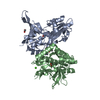
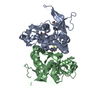
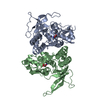
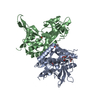
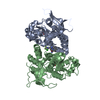


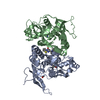
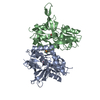

 PDBj
PDBj




